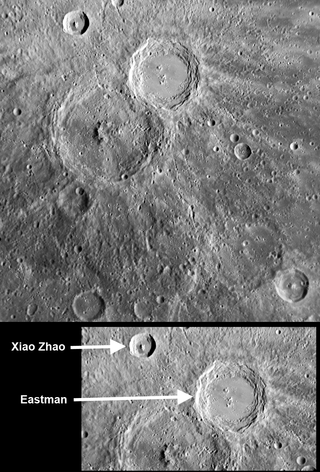
Petrarch is a crater on Mercury. This crater is located within the distorted terrain on the opposite side of the planet from the Caloris Basin. It was named after Petrarch, the medieval Italian poet, by the IAU in 1976.

Matisse is an impact crater on the southern hemisphere of Mercury. Matisse takes its name from the French artist Henri Matisse, and it was named by the IAU in 1976.

Raphael is a crater on Mercury. Its name was adopted by the International Astronomical Union (IAU) in 1976, and is named for the Italian painter Raphael.

Homer is a crater on Mercury. It is one of 110 peak ring basins on Mercury.

Verdi is an impact crater on the planet Mercury. It was named after Italian Romantic composer Giuseppe Verdi (1813–1901) in 1979, as recognized by the International Astronomical Union. The crater's extensive ejecta blanket and secondary crater field are superposed on plains materials and older craters.

Praxiteles is a crater on Mercury. It is one of 110 peak ring basins on Mercury.

Abedin is a crater on Mercury. It was named after the Bangladeshi artist Zainul Abedin by the IAU in 2009.

Izquierdo is a crater on Mercury. Its name was adopted by the International Astronomical Union (IAU) in 2009, for the Mexican painter María Izquierdo. The floor of Izquierdo is smooth, the result of having been partially filled with volcanic lava. Circular outlines of the rims of “ghost craters” – smaller, older craters that have been largely buried by the lavas that infilled the basin – are visible in a few places on Izquierdo's floor. The remnants of a buried inner ring are also barely discernible in spots, and it is one of 110 peak ring basins on Mercury. There have been more recent impacts into the floor of Izquierdo, resulting in some small, sharply defined craters.

Eastman is a crater on Mercury first seen by MESSENGER during the mission's first Mercury flyby. Eastman exhibits some features characteristic of a fresh, relatively young crater. The walls of Eastman have clearly visible terraces, and the central peak structure is well preserved. Eastman is located near Xiao Zhao crater.

Copland is an impact crater on Mercury. Its floor is flooded with volcanic smooth plains material, which could be related to the activity that formed the nearby bright vent known as Nathair Facula.

Picasso is a crater on Mercury. It has drawn scientific attention because of the large, arc-shaped pit crater located on the eastern side of its floor. Similar pits have been discovered on the floors of several other Mercury craters, such as Beckett and Gibran. These pits are postulated to have formed when subsurface magma subsided or drained, causing the surface to collapse into the resulting void. If this interpretation is correct, pit-floor craters such as Picasso provide evidence of shallow magmatic activity in Mercury's history.

Janáček is a crater on Mercury. It has a diameter of 47 kilometers. Its name was adopted by the International Astronomical Union (IAU) in 1985. Janáček is named for the Czech composer Leoš Janáček, who lived from 1854 to 1928. The MESSENGER Mercury orbiter crashed near the crater on 30 April 2015.

Wagner is an impact crater in the south polar region of the planet Mercury. It was named after the German composer Richard Wagner (1813–1883) in 1976, as recognized by the International Astronomical Union. It is located in the Bach quadrangle, between Bach and Chopin.

Carolan is a crater on Mercury. Its name was suggested by an Irishman, Fergal Donnelly, and two Americans, Joseph Brusseau and Deane Morrison, in a naming contest which was eventually adopted by the International Astronomical Union (IAU) on 2015. Carolan is named for the Irish composer and performer Turlough O'Carolan, who lived from 1670 to 1738 C.E. The craters Kulthum, Enheduanna, Karsh, and Rivera were also named as part of the contest.

Enheduanna is a crater on Mercury. It has a diameter of 105 kilometers. Its name was suggested by Gagan Toor from India in a naming contest which was eventually adopted by the International Astronomical Union (IAU) on 2015. Enheduanna is named for the Sumerian poet Enheduanna. The craters Carolan, Kulthum, Karsh, and Rivera were also named as part of the contest.

Kulthum is a crater on Mercury. It has a diameter of 31 kilometers. Its name was suggested by Molouk Ba-Isa from Saudi Arabia, Swiss individual Riana Rakotoarimanana, and American residents Yehya Hassouna, David Suttles, Thorayya Said Giovannelli and Matt Giovannelli in a naming contest which was eventually adopted by the International Astronomical Union (IAU) on 2015. Kulthum is named for the Egyptian singer Umm Kulthum.

Rivera is a crater on Mercury. It has a diameter of 40 kilometers. Its name was suggested by Mexican residents Ricardo Martinez and Arturo Gutierrez, and American residents Rebecca Hare and José Martinez, in a naming contest which was eventually adopted by the International Astronomical Union (IAU) on 2015. Rivera is named for the Mexican poet Diego Rivera. The craters Carolan, Enheduanna, Karsh, and Kulthum were also named as part of the contest.

Nabokov is a crater on Mercury. Its name was adopted by the International Astronomical Union (IAU) on April 24, 2012. Nabokov is named for the Russian and American author Vladimir Nabokov.



















